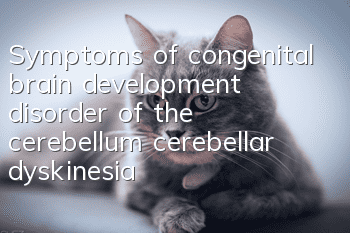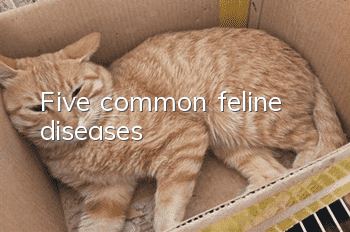Symptoms of congenital brain development disorder of the cerebellum (cerebellar dyskinesia) in cats

This disease is the most common congenital brain development disorder in cats (cerebellar atrophy, hypoplasia, complete agenesis), also called cerebellar dyskinesia.
Reason
1. It is most common to be infected with feline granulocytopenic leukemia virus (feline parvovirus) during the fetal period or early postnatal period.
2. Congenital anatomical malformations of the central nervous system of unknown origin.
3. It was previously thought to be related to genetic factors, but this has now been denied.
Symptoms
1. Symptoms due to cerebellar dysfunction are the most eye-catching. Loss of coordinated movement of the head, trunk and limbs, movement disorder, head trembling, body swinging frequently, inability to maintain a normal posture, difficulty maintaining standing balance (generally falling to one side or back, sometimes falling to the front and somersaulting) , Nodding movement (caused by uncoordinated flexion and extension of neck muscles).
2. Symptoms such as circular movements, convulsive attacks, nystagmus, opisthotonus, standing with limbs spread apart, scissor-like gait, abnormal movement of limbs, and muscle weakness are also common.
3. These symptoms can exist after birth, but at this time it is difficult to distinguish them from normal cat movements. Therefore, symptoms generally begin to become apparent during the period when kittens can walk normally (3 to 4 weeks after birth).
4. The symptoms become more obvious as the kitten grows and becomes more lively (even if the kitten wears a blindfold, the movement disorder still exists). At this time, the damage to the cerebellar tissue has been completed and the symptoms will no longer worsen. Gait sometimes improves as compensatory mechanisms come into play.
5. The severity of symptoms is determined by the degree of cerebellar developmental disorder.
6. When the cerebellar developmental disorder is mild, the cat is full of energy, lively and active, and is close to normal cats. But they are usually in a severe state where they cannot walk.
7. Temporary loss of reflexes and spinal cord hyperreflexia.
8. Under normal circumstances, feeding and chewing can be carried out normally, but when the condition is severe, the feeding movements cannot be coordinated and the body gradually becomes thinner.
9. No pain.
10. Although this disease is not fatal, as a virus carrier, sometimes it continues to shed the virus for several months and becomes a source of infection for other cats.
Diagnosis
1. Although this disease needs to be differentiated from head trauma, hydrocephalus and spinal cord defects in newborn kittens, if the above-mentioned typical symptoms appear when the kittens begin to walk, this disease should be suspected first.
2. According to naked eye observation, the cat is a cat with cerebellar hypoplasia. Although the collapse of the posterior cranial fossa can be seen on the X-ray of the side of the head. But this feature is not always visible. In addition, the severity of the disease is not necessarily related to the cerebellumare parallel in size.
3. During autopsy, varying degrees of cerebellar atrophy can be seen with the naked eye (the brain and medulla oblongata are normal in size), and histological observation has characteristic manifestations (the molecular layer cells, Purkinje cells and granular layer cells of the cerebellar cortex are significantly Reduced or even disappeared), which can be used to diagnose the disease.
4. The virus is isolated from cerebellum tissue, viral antigens are detected by fluorescent antibody method (mainly in Purkinje cells), and high titers of virus-neutralizing antibodies detected in the blood can also help confirm the diagnosis.
Treatment
1. There is no good treatment for this disease.
2. For those with mild illness, giving exercise inhibitors can sometimes play a certain role.
Note: Kittens under 4 weeks of age and pregnant cats should not be vaccinated with live feline granulocytopenic leukemia virus vaccine. The granulocytopenic leukemia virus has a high affinity to cells that are actively dividing. The central nervous system of newborn cats, especially the granular layer cells of the cerebellum, is highly susceptible to the virus, which is an important factor in the occurrence of the disease. Transplacental The risk of infection and disease in newborn kittens also exists, so it is harmful for cats during this period to be vaccinated with live vaccines.
- Tips for removing black chin in cats
- What does a cat eat to produce a lot of milk?
- The kitten keeps blinking one eye
- What to do if a cat is afraid of people
- There's a reason why cats always lick their fur
- What should I do if my cat refuses to have its nails cut?
- What should I do if my cat refuses to cut its nails? The shit shovel officer can do this!
- How to choose a Russian blue cat
- How to check if your cat has fleas and ticks?
- How to tell if a cat has a fever? Will a cat's fever heal on its own?



